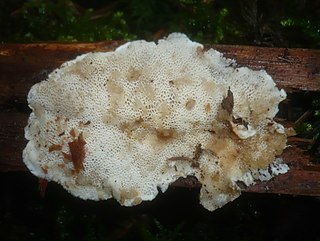
The Tremellomycetes are a class of dimorphic fungi in the Agaricomycotina. Some species have gelatinous basidiocarps or (microscopically) a sacculate parenthesome. There are six orders, 17 families, and 39 genera in the Tremellomycetes. Tremellomycetes include yeasts, dimorphic taxa, and species that form complex fruiting bodies. Tremellomycetes include some fungi that are human and animal pathogens in the genera Cryptococcus, Naganishia, Papiliotrema, and Trichosporon and some fungi that are cultivated for food in the genera Tremella and Naematelia.
The Cystofilobasidiales are an order of fungi in the class Tremellomycetes of the Basidiomycota. They usually exhibit a life phase of free-living yeasts. The order contains two families with seven genera and some 25 species.
The Filobasidiales are an order in the fungal class Tremellomycetes. The order contains two families and seven genera.
The Cuniculitremaceae are a family of fungi in the order Tremellales. There are three genera in the family. Sterigmatosporidium polymorphum parasitizes other fungi growing in insect galleries in wood. It does not produce basidiocarps, but has septate basidia similar to those found in the genus Tremella. Most species are known only from their yeast states.
Bullera is a genus of fungi in the family Bulleraceae. The genus, which comprises both anamorphic and teleomorphic forms, formerly contained some 35 species. Molecular research, based on cladistic analysis of DNA sequences, has however assigned most of these species elsewhere and reduced the genus Bullera to just four species. Anamorphic forms are yeasts; teleomorphic forms produce septate basidia resembling those of Tremella species, but are not known to produce basidiocarps.
Dioszegia is a genus of fungi in the family Bulleribasidiaceae. The genus, comprising anamorphic forms, has a widespread distribution, and contains around 16 species.
Kwoniella is a genus of fungi in the family Cryptococcaceae. The genus originally contained the single species Kwoniella mangrovensis, found in the Florida Everglades and The Bahamas. Molecular research, based on cladistic analysis of DNA sequences, has however, now extended the genus to eleven species, most known only from their yeast states.
Trimorphomyces is a genus of fungi in the family Trimorphomycetaceae. The genus currently contains two species. The type species is a parasite of another fungus in the genus Arthrinium, forming small gelatinous basidiocarps containing distinctive twinned conidia.
The Mrakiaceae are a family of fungi in the order Cystofilobasidiales. Phylogenetic analyses shows that this family is clearly distinct from other yeast-like families of the Tremellomycetes. The family had six genera in 2015.
Cystofilobasidium is a genus of fungi in the family Cystofilobasidiaceae. Species occur as yeasts, but produce filamentous sexual states that form dikaryote teliospores, from which the unicellular basidia are formed. The hyphae usually have dolipore septa without a parenthesome, and their cell walls contain xylose. The genus currently contains nine species worldwide.
Naganishia is a genus of fungi in the family Filobasidiaceae. Species are currently only known from their yeast states, most of which were formerly referred to the genus Cryptococcus. Some 15 species have been described worldwide. Naganishia albida is an occasional human pathogen.
The Bulleraceae are a family of fungi in the order Tremellales. The family currently contains five genera. Some species produce gelatinous basidiocarps and were formerly placed in the genus Tremella. Most, however, are only known from their yeast states.
The Piskurozymaceae are a family of fungi in the order Filobasidiales. Most species are only known from their yeast states, but some produce filamentous sexual states with basidia that are parasitic on other fungi. The family currently contains two genera.
Solicoccozyma is a genus of fungi in the family Piskurozymaceae. Species have only been isolated in their yeast states, several of which were formerly referred to the genus Cryptococcus, but can produce filamentous states with basidia in culture. Nine species have been described worldwide.
The Trimorphomycetaceae are a family of fungi in the order Tremellales. The family currently contains four genera. Some species produce filamentous sexual states and are parasites of other fungi. Most, however, are only known from their yeast states.
The Trichosporonales are an order in the fungal class Tremellomycetes. The order contains two families and ten genera. Several species in the Trichosporonaceae are human pathogens.
The Tetragoniomycetaceae are a family of fungi in the order Trichosporonales. The family currently contains four genera. Several species are only known from their yeast states.

The Carcinomycetaceae are a family of fungi in the order Tremellales. The family currently contains a single genus. Some species produce filamentous sexual states with basidia and are parasites of other fungi. Some, however, are only known from their yeast states.
Apiotrichum is a genus of fungi in the family Trichosporonaceae. Species are only known from their yeast states, most of which were formerly referred to the genus Trichosporon. Twenty species have been described worldwide. Apiotrichum mycotoxinivorans is an occasional human pathogen.

Carcinomyces mycetophilus is a species of fungus in the class Tremellomycetes. It is a parasite, producing extensive, gelatinous galls on basidiocarps of its host, the agaric Gymnopus dryophilus. Its generic placement is currently uncertain, but morphologically it is close to the type species of Carcinomyces. It was first described by Charles Horton Peck from North America, where it is widespread and called Collybia jelly. It has also been recorded in continental Europe.


